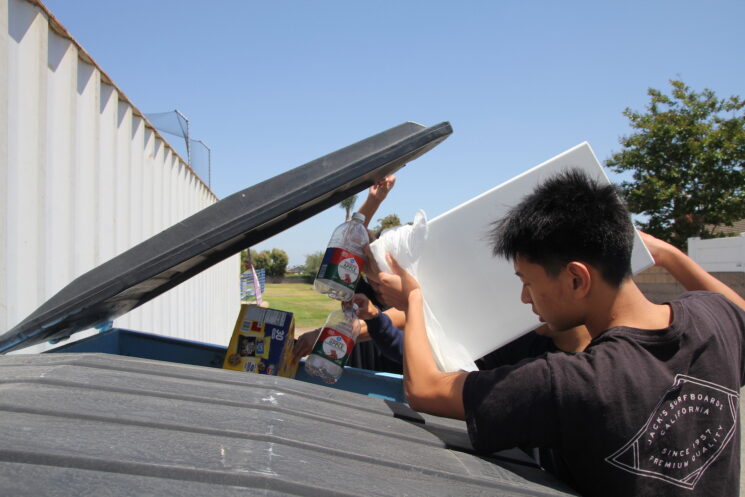
By Reese Meister
Fountain Valley High School (FVHS) distributes free school lunches in plastic and paper containers, but alternatives could be more sustainable options. Currently, the Huntington Beach Union High School District (HBUHSD) purchases products from Sysco Co. Los Angeles. According to the HBUHSD Nutrition Services Operation Supervisor, Melissa Erman, only some of the containers are recyclable, compostable or made from recycled materials.
FVHS AP Environmental Science teacher Terah French suggested several methods to improve campus sustainability. She noted that the Ecology Club runs the campus recycling program and that the school could create a similar system on a larger scale. With a more extensive program, the impact of using recyclable materials would grow.
While the Ecology Club has gained more participation in recycling this year compared to previous efforts, a school-wide system could have a greater influence on the district’s decisions. French believes that data from school-wide recycling may help the district realize the program’s ability to reduce amounts of packaging and money spent.
The most ideal option, according to French, would be to have students bring reusable materials from home to collect their lunch from the cafeteria, or at least to incentivize doing so. She even suggested that businesses like Tropical Smoothie Café, where students bring food from, begin selling reusable cups in order to promote sustainability in popular off-campus sites.
“I think a lot more students are more conscious of [sustainability] and would be willing to bring a little lunch sack that had a bamboo plate or a bamboo straw or something like that,” French said. “You’d have to kind of incentivize it, maybe have something… where you had clubs that were selling reusable items that students could use on campus.”
This method could reduce both the packaging waste and the cost of containers used to distribute meals. However, French understands the difficulty in a system like this because of the HBUHSD’s focus on packaging in volume to maximize cost efficiency. HBUHSD likely looks for a company that can provide packaging to all of its sites for the best cost.
“Essentially [the district has] a purchasing division, which basically negotiates contracts with companies,” French said. “If the district is saying we want things [that] are… recyclable materials or that are… made from recycled materials, they are going to need to basically price that out with different companies, and then find out how much it would cost them. So my guess is, it’s going to come down to a cost and volume issue.”
Though Erman could not provide the HBUHSD packaging costs, she acknowledged that they influence decisions on meal distribution methods.
“Cost plays a significant role in deciding where purchases are made. As a government entity, we must always go with the lowest bidder,” Erman said. “As a whole, we would like all of our containers and products to be made with recycled materials. Unfortunately, we are not able to accomplish this due to many other factors in the purchasing process required as a school district.”
French guessed that COVID-19 has also played a role in decisions for school lunch distribution methods. In the 2020-2021 school year and the beginning of this school year, the cafeteria was closed to students, which would have limited the possibility of using reusable trays and containers.
With so many factors limiting the changes that the district could realistically implement, the most viable option as of now would be to purchase only materials that are recyclable, compostable and made of recycled materials. FVHS should be able to expand its composting and recycling programs on campus.
“I do know that the cafeteria would like to compost wasted food— your fruits, vegetables, things that haven’t been eaten,” French said. “I know that they have expressed interest in it, but I don’t know how much they’ve actually gotten a process going.”
On the other hand, the cost difference between current packaging and more sustainable packaging may not be as significant as some imagine. The extra expense, in fact, could be worth the benefit to the environment and example for the community.
“I think that because of consumer demand,… the prices for recycled products has gone down significantly. And I think that’s something that a district should be able to look at, at this standpoint, in order to [become] more sustainable,” French said. “From a sustainability standpoint, that’s kind of huge given our volume of supplies that we use for our district… We want to basically be role models for the environment at the bigger level.”
Even simple changes on campus can help increase FVHS’s sustainability. French mentioned the success of the implementation of water stations, which allow students to refill their own reusable water bottles rather than purchasing plastic ones from the cafeteria.
The Ecology Club’s recycling system uses bags made from recycled plastic; however, the trash bags currently provided by the school are not sustainable. Even spending a bit more to use bags made of recycled materials could make a difference and help create a more sustainable mindset in the community.
“When you’re using recycled plastic you are reducing the fossil fuel basically being processed to make plastics,” French said. “You’re also increasing greenhouse emissions when you’re [making plastics]. So when we are reducing plastics, we’re also reducing fossil fuel use… If we can do those two in combination, I think that would be a good thing.”
Overall, the voice of the community may have the greatest ability to spark change. Students especially possess the power to draw attention to this issue and encourage the district to make a difference.
“Student pressure and parent pressure being relayed to the district about how important this is to them I think actually would be the biggest motivator and maybe drive for change— and having these programs be realistic and not labor-intensive,” French said. “It’s got to be something that can be easily replaced or easily done, and it has to be practical.”





